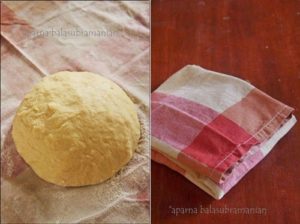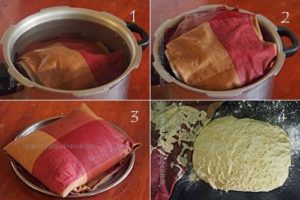
Water-Proofed Bread (It's Not Water Proof!)
I.
Ingredients
- 2 1/4 tsps active dry yeast
- 1/2 cup water warm
- 1 tsp sugar granulated (to proof yeast)
- 1/4 cup sugar granulated
- 1/2 cup milk warm
- 75 gm butter
- 1 tsp salt
- 2 eggs
- 3 1/2 to 4 cups all-purpose flour
- flour tea More for dusting work surface and towel
Instructions
- If thereu2019s a chance to let a machine (my trustworthy food processor since I donu2019t have stand mixer) knead my dough, then I will use it. However the thought of having to clean up after it mixed sticky dough was daunting so I did this entirely by hand.
- Put in the yeast, the warm water, the 1 tsp sugar, and stir until the yeast dissolves. Allow this to proof for 5 minutes. Heat the milk with the butter and 1/4 cup sugar until lukewarm, then add to the yeast mixture. Add the salt and stir to blend well with a spatula.
- Add the eggs, one at a time, and again stir thoroughly. Then stir in 3 cups of flour, 1 cup at a time, vigorously. (I needed to use 3 1/2 cups of flour here.) You will have a very wet and sticky dough. Sprinkle about 1/2 cup of flour on your work surface and turn out the dough on this.
- Use a baker's scraper or large spatula to work in this last portion of flour and make the dough firmer. Scrape under the flour and the dough, lifting and folding inward. Repeat until the flour is well incorporated. You might need to add a little more flour but be a little conservative as too much flour will spoil the texture of the bread.
- When the dough is easy to handle, begin kneading by hand. Continue until the dough can be shaped. The process of kneading first with the scraper, and then by hand is very effective for delicate dough. In this case the dough will remain rather sticky, but don't worry about it.

- Lift the dough, pat with flour, and place on a clean kitchen towel also sprinkled with flour. Wrap it and tie it in the towel, just as you would a package, but very loosely to allow for the expansion of the dough. I chose not to tie up the package because my towel was large enough to wrap it up well. Submerge this packet in a large bowl (I used my pressure cooker without the lid) filled with water from the tap (not cold or warm). It will sink.
- Let sit for about 35 to 40 minutes, or until it rises sufficiently to float on top of the water. This is the time required for the first rise of the bread dough.
- Lift the dough from the water and let the excess water drip off. Place the package on a towel so that all the excess water is absorbed. Un-wrap and turn out the dough onto a lightly floured surface. Again it will be quite sticky, so scrape off any dough that adheres to the towel. Knead and shape into two loaves, using both dough scraper and your hands.

- Thoroughly butter two small -medium sized loaf pans (I used 6u201d by 4 1/2" by 2u201d pans) and place one loaf in each pan. Cover, put in a warm, draft-free place, and let the dough rise slightly above the tops of the pans, or until almost doubled in bulk. My dough took about an hour to do so.
- Brush the tops of the risen loaves with cold water, and if you like slash the tops with a sharp knife. Bake them at 180C (350F) for about 25 to 35 minutes until the loaves have browned and sound hollow when tapped. When done, if you like remove the loaves from the pans and place them directly on the oven rack, to brown the bottom a little more and crisp the crusts. Cool on racks.
- Make sure the loaves are completely cool before slicing them.
Notes
This recipe makes two small loaves of bread
The Bread Baking Babes are:
Bake My Day – Karen
Bread Baking Babe Bibliothécaire – Katie
Blog from OUR kitchen – Elizabeth
Feeding my enthusiasms – Elle
Girlichef – Heather
Life’s A Feast – Jamie
Living in the Kitchen with Puppies – Natashya
Lucullian Delights – Ilva
My Kitchen In Half Cups – Tanna
Notitie Van Lien – Lien
Bread Experience – Cathy
Elle at Feeding My Enthusiasms is the Kitchen of the Month. If you'd like to join us baking this bread as a Bread Baking Buddy, see the recipe for the Water-Proofed Bread and bake away (adaptations are allowed). Then post about it on you blog before March 29th, and send Elle your link (you can find the details on her blog)